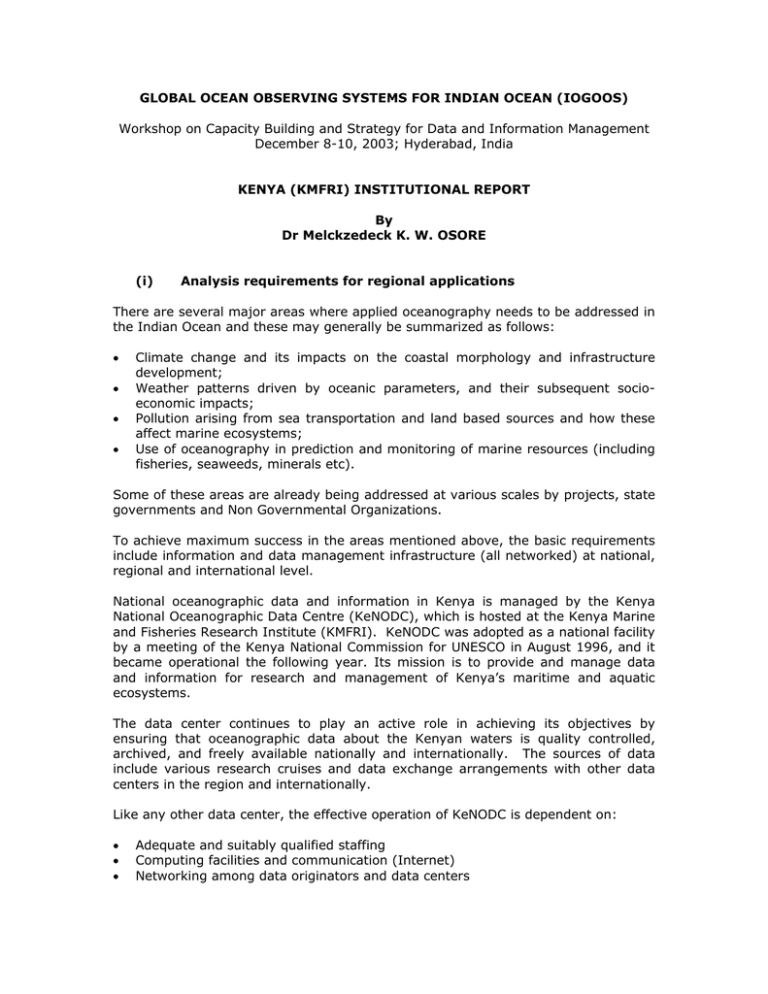GLOBAL OCEAN OBSERVING SYSTEMS FOR INDIAN OCEAN (IOGOOS)
advertisement

GLOBAL OCEAN OBSERVING SYSTEMS FOR INDIAN OCEAN (IOGOOS) Workshop on Capacity Building and Strategy for Data and Information Management December 8-10, 2003; Hyderabad, India KENYA (KMFRI) INSTITUTIONAL REPORT By Dr Melckzedeck K. W. OSORE (i) Analysis requirements for regional applications There are several major areas where applied oceanography needs to be addressed in the Indian Ocean and these may generally be summarized as follows: • • • • Climate change and its impacts on the coastal morphology and infrastructure development; Weather patterns driven by oceanic parameters, and their subsequent socioeconomic impacts; Pollution arising from sea transportation and land based sources and how these affect marine ecosystems; Use of oceanography in prediction and monitoring of marine resources (including fisheries, seaweeds, minerals etc). Some of these areas are already being addressed at various scales by projects, state governments and Non Governmental Organizations. To achieve maximum success in the areas mentioned above, the basic requirements include information and data management infrastructure (all networked) at national, regional and international level. National oceanographic data and information in Kenya is managed by the Kenya National Oceanographic Data Centre (KeNODC), which is hosted at the Kenya Marine and Fisheries Research Institute (KMFRI). KeNODC was adopted as a national facility by a meeting of the Kenya National Commission for UNESCO in August 1996, and it became operational the following year. Its mission is to provide and manage data and information for research and management of Kenya’s maritime and aquatic ecosystems. The data center continues to play an active role in achieving its objectives by ensuring that oceanographic data about the Kenyan waters is quality controlled, archived, and freely available nationally and internationally. The sources of data include various research cruises and data exchange arrangements with other data centers in the region and internationally. Like any other data center, the effective operation of KeNODC is dependent on: • • • Adequate and suitably qualified staffing Computing facilities and communication (Internet) Networking among data originators and data centers (ii) The current scenario The main thrust of the activities at KeNODC includes creating awareness among various national partners including scientists and institutions in Kenya, on services that can be provided by the Center. A series of national workshops have been held annually where products and services are demonstrated. This year, KeNODC conducted a national Workshop in August 25-27 entitled “Informing the Coastal Management Process”. Participation was drawn from national institutions including Coast Development Authority, Mines and Geological Department, Kenya Wildlife Services, Ministry of Water Resources Management and Development, Fisheries Department and the regional Project Coral Reef Degradation in the Indian Ocean. Data and information presented is being incorporated into various databases and data products. Various data originators in the country are encouraged to submit meta-data to the data center, which is entered in the national metadata base. Internet connection is available at the moment using 64 Kbps digital lease line connection to Telkom Kenya, which is the national telecommunication services provider. Staff at the KeNODC has been trained to routinely handle a variety of data and information. They have the basic training for using computer software such as INMAGIC, Ms-Access, Ms-Excel, Ocean data view, Surfer etc with which they produce a number of databases and gridded datasets. (iii) Limiting factors Lack of a standard format of recording may render some data difficult to decode and archive. In other cases data is lost once the primary need has been achieved, and this is where majority of the cases fall. The limited staff manning the center may also not understand all of the data received by the data center. Computer formats of data also vary a great deal and require a lot of software tools some of which are expensive or require extended training (faster formats, vector data, HDF formats etc). Although KMFRI has a stable Internet connectivity, it has been difficult to take full advantage of it at the national level because most of the national institutions are not connected due to prohibitive costs or bureaucracy. Additionally, very few scientists in the country have the necessary skills to integrate the wide array of datasets for modeling and prediction. (iv) Strategy for the region To develop a strategy for ocean data and information management in Kenya and the region, the following key aspects are envisaged: • Defining detailed scope of activities • • Strengthening networking infrastructures by having active national and regional hubs Developing and implementing training programs for middle level personnel and higher level ones in priority areas. (v) Plan for capacity building Developing plan fro capacity building for data and information management will involve: • Set of training in data management (curriculum to be discussed) • Set of training in information management (curriculum to be discussed) • National priority setting workshops • Regional priority harmonization workshops • Infrastructure strengthening for national centers • Discussion for operational needs of each center and how to meet such needs (via national governments, donors projects etc). The Project Ocean Data and Information Network for Africa (ODINAFRICA) has initiated some of the above points but they might not be executed beyond the life span of the project, which ends in December 2003. (vi) Evolving framework for establishing a regional ODIN The current functions of the national center can be upgraded, improved and suited appropriately to evolve into wider functions to serve the entire region. (vii) Identifying work plan for the next 3-4 year The resources and requirements should reflect most of the points highlighted in part V above. (viii) Coordination mechanism For efficiency, we can adopt the present working mechanism that we have, whereby national coordination is done by the data center. To be exhibited: CD ROM containing some data sets of the Kenya coast Poster of KeNODC activities Brochure


